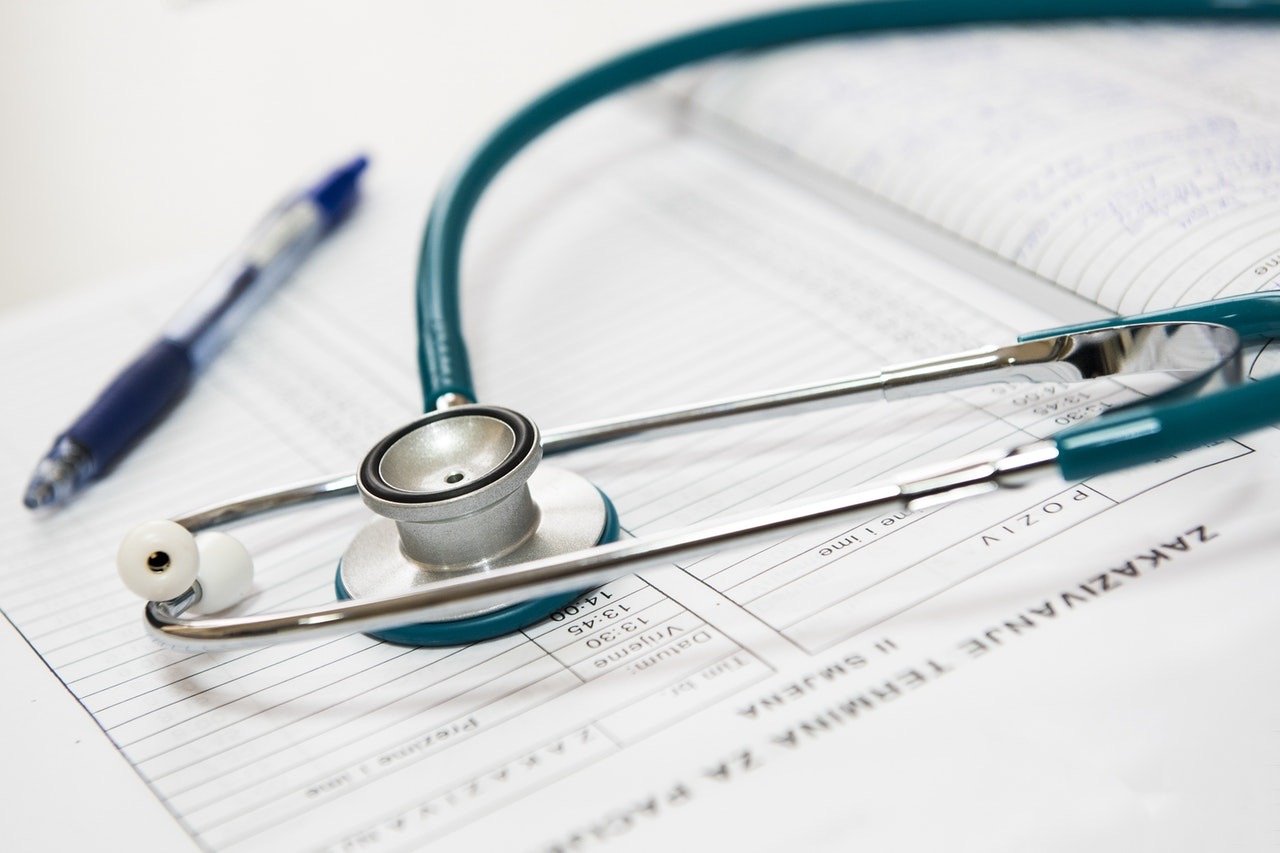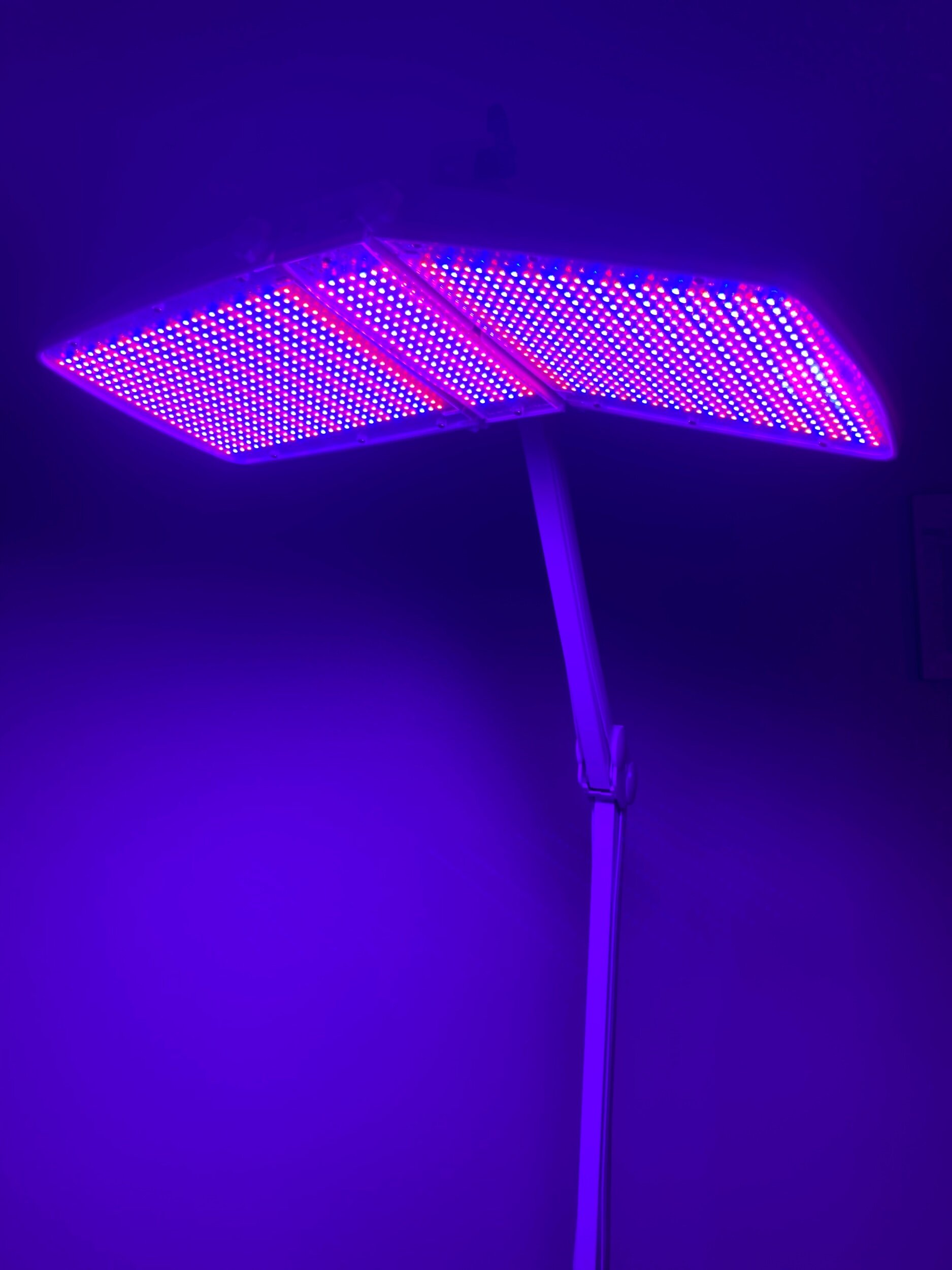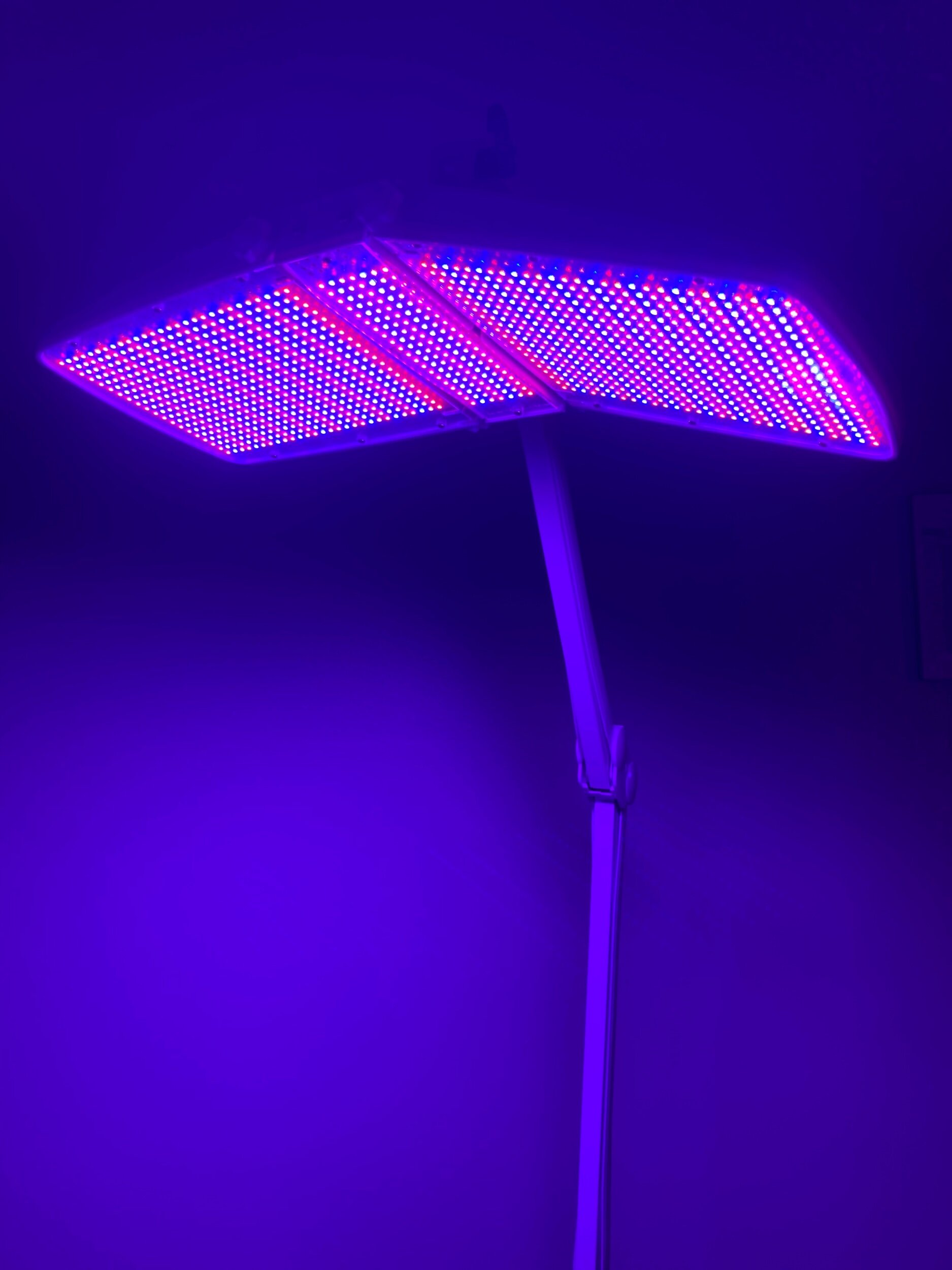
Red Light Rejuvenation Therapy for Wellness
With red light therapy, you can strengthen your immune system, relieve joint pain, sleep better, increase circulation and blood flow, among much more.
You CAN feel good again!
“Nearly every disease state known to man has been linked to low mitochondrial activity. Understanding which foods and factors enhance metabolism, and which inhibit it are paramount for successfully preventing or reversing disease.
—Mark Sloan, Red Light Therapy: Miracle Medicine.”

Red Light Therapy Benefits:
Skin Conditions
Cellulite
Loose skin
Wrinkles
Stretch marks
Wound and scar healing
Vitamin D
Hair growth
Allergic reactions such as rashes, wheezing, and throat swelling
Oral health
Pain and inflammation
Arthritis-related joint pain and stiffness
Immune health
Cognitive function
Mental health and depression
Weight loss and body contouring
Muscle growth, athletic performance, and recovery
Hormone health and sex drive
Eye health
Sleep disturbances
In Depth Break-Down
RED LIGHT THERAPY functions mainly by causing a biochemical reaction within the mitochondria cells that allows it to use oxygen more efficiently to produce energy in the form of ATP. ATP is known as the body's energy currency and is responsible for the proper functioning of every organelle, cell, tissue, and organ in the body. Unfortunately, ATP synthesis can lag for several reasons, leading to myriad health issues, including those related to the skin.
One of the most significant effects of more efficient energy synthesis at the cellular level is increased collagen production. As mentioned above, collagen is an essential protein for healthy, youthful-looking skin. It plays a significant role in healing wounds and scars, reducing wrinkles and fine lines, and providing firmness to the skin.
Red light therapy has also improved blood flow by causing vasodilation (widening of blood vessels). This creates a positive feedback loop in which better circulation allows for more oxygen to reach the cells, boosts energy production, improves blood flow, and so on. Red light therapy is also known to reduce inflammation, in part through improved blood flow, but also through the exact mechanism on which micro-needling relies: hormesis. This involves what is known as oxidative stress.
Defined as an imbalance between free radicals and antioxidants in the body, oxidative stress occurs when an oxygen molecule is broken down into single atoms with an uneven number of electrons. Electrons always want to be in pairs, so these molecules, called free radicals, roam free looking for other molecules to pair with. This causes damage to cells, proteins and DNA, which in turn can lead to a number of serious pathological conditions, including inflammatory skin diseases, and can also cause skin wrinkling and other signs of aging.
Antioxidants are the benevolent molecules that essentially sacrifice themselves to free radicals by offering up electrons, thereby preventing damage to healthy molecules. When free radicals become too abundant for antioxidants to keep under control, we have what is called oxidative stress.
While it is generally considered to be harmful, research indicates that oxidative stress in small doses can be beneficial to the body and can help fight a wealth of pathological conditions by both slowing down the growth of certain cells and by creating protective mechanisms to neutralize and eliminate free radicals.
Red light therapy has been demonstrated to cause a temporary increase in free radicals (also called reactive oxygen species (ROS), causing the body to jumpstart its defense mechanisms.
Dr. Lange's office offers Red Light Therapy to treat Chronic Skin Conditions, Psoriasis, eczema, acne, and other chronic skin conditions are currently considered incurable. Treating chronic inflammation and mitochondrial dysfunction and improving the health of newly formed skin cells can push these disorders into remission, Low back pain, or muscle strains, Hair Restoration, diabetic peripheral neuropathy, Red light reduces arthritis inflammation to help slow or potentially reverse the degeneration of the joints. It also increases collagen production to help joints stay supple and increases blood flow for better waste disposal and nutrient delivery. In addition, several studies show that red light eases osteoarthritis pain and it's a safe therapy for long-term treatment.
Red light therapy is a therapeutic technique that uses low-level wavelengths of light to treat a number of conditions, from pain relief to anti-aging.
As a safe and minimally invasive solution, infrared light offers an effective alternative to traditional drugs as a method of healing wounds and reducing the pain of inflammation. low-level light therapy is FDA-approved for treating conditions like chronic joint pain, hair loss, and may even help repair brain tissue.
But what about the possible side-effects? First, it's important to take a look at the beginnings of red light therapy.
The Beginnings of Red Light Therapy
In the early 1990s, NASA began studying red light spectrums in order to determine the beneficial effects on growing food in space. 1 The researchers found that the intense light from red light-emitting diodes (LEDs) helped promote the growth of plant cells.
These findings were intriguing and researchers around the world took note. Increasing amounts of research were then devoted to the effects of red light on organisms. Specifically, the wavelengths of light were found to have a positive effect on living tissue.
The basic process of red light and near-infrared (NIR) infrared therapy involves exposure to red and NIR light by means of low light lasers or LED lights. The process is known by many names, including:
photobiomodulation (PBM)
low-level light therapy (LLLT)
soft laser therapy
cold laser therapy
biostimulation
photonic stimulation
low-power laser therapy (LPLT)
The Effects of Red Light on Bio Organisms
Research supports that specific light wavelengths cause a biochemical effect in cells that boost the energy production of mitochondria. A study in the journal Seminars in Cutaneous Medicine and Surgery notes, mitochondria in the skin cells can absorb these light particles, boosting a cell's energy with the creation of adenosine triphosphate (ATP). 2
You can think of the mitochondria as the powerhouse of the cell. By increasing ATP production, the cell has more energy to function more efficiently and repair damage. LED light therapy is also thought to contribute to building up the cell's antioxidant and anti-inflammatory defense systems.
When red light therapy is used with medications such as lithium, melatonin, phenothiazine antipsychotics and certain antibiotics, it's referred to as photodynamic therapy. In this type of therapy, light is only used as an activating agent.
Red Light Therapy vs. Medications
Inflammation is generally treated with medications, which can have serious side-effects. The use of red light therapy in treating inflammation without the side-effects of traditional medications is showing great promise. Here are a few anti-inflammatory medications and their related risks. (Note, RED LIGHT THERAPY does not present any side effects and is a safe and healing wavelength).
NSAIDs
Over the counter varieties of NSAIDs (non-steroidal anti-inflammatory drugs) include aspirin, ibuprofen (Advil), and naproxen (Aleve). According to the Cleveland Clinic, common side effects of NSAIDs include: Stomach pain and heartburn, Stomach ulcers, tendency to bleed more, especially when taking aspirin. Your doctor might tell you to stop taking NSAIDs before surgery. Ask your doctor before taking NSAIDs if you are on blood-thinning medications (such as Coumadin), Headaches and dizziness, Ringing in the ears, Allergic reactions such as rashes, wheezing, and throat swelling, Liver or kidney problems. If you have any kidney problems, you shouldn't take NSAIDs without checking with your doctor, High blood pressure, Leg swelling, Gas, Feeling bloated, Nausea, Vomiting, Diarrhea and/or constipation 3
Steroids
The use of steroids is often a treatment for fighting inflammation. Steroids decrease inflammation and suppress the immune system, which is helpful when it starts attacking healthy tissue. But long-term use of steroids can lead to vision problems, high blood pressure, and osteoporosis. When prescribing steroids, your doctor will weigh the benefits and risks with you.
Supplements
Some supplements have shown promise in treating inflammation, including fish oil, lipoic acid, and curcumin. Several spices are also noted for relieving inflammation, including ginger, garlic, turmeric, and cayenne.
Efficacy and Safety of Red Light Therapy
Red light therapy doesn't cause damage to the skin's surface, which differs from laser or intense pulsed light (IPL) therapy. Light wavelengths work by causing damage to the outer layer of skin, inducing tissue repair. Differently, red light penetrates only about 5 millimeters into the skin, directly stimulating cell regeneration and collagen production.
Full-spectrum light can result in sunburns if the light does not have a diffuser which filters out the ultraviolet wavelengths. Lamps used in modern light therapy that filter out ultraviolet rays are considered to be safer, but caution should be used for photodynamic therapy.
As noted in News-Medical.net, "When photodynamic therapy is pursued, physical hazards such as non-ionizing radiation produced by the light-emitting device and chemical hazards such as undesirable exposure to photosensitizing agents applied to patients must be considered for safe use by the healthcare professional."
How Red Light Therapy Works for Cancer Treatment
In a study examining the effects of red light therapy on tumor growth, it was found that treatments showed some promise without presenting safety concerns.
"The present study failed to demonstrate a harmful effect of whole-body red light on tumor growth in an experimental model of UV-induced SCC. There was a transient and small reduction in relative tumor area in the treatment group compared with controls. This study suggests that LLLT should not be withheld from cancer patients on an empiric basis."
Treatment of Skin Conditions
A 2014 study examined the safety of red light therapy in treating a number of skin conditions that require a reduction of inflammation while studying the safety of the treatments. The researchers concluded:
"In pigmentary disorders such as vitiligo, LLLT can increase pigmentation by stimulating melanocyte proliferation and reduce depigmentation by inhibiting autoimmunity. Inflammatory diseases such as psoriasis and acne can also benefit. The non-invasive nature and almost complete absence of side-effects encourages further testing in dermatology."
Are There Medical Conditions Tied to Red Light Therapy?
There are no studies tied directly to the use of red light therapy and those who experience photosensitivity reactions, it is recommended that you do a skin sensitivity test before undergoing any light therapy. Individuals react differently to exposure to light. While most have no reaction, some may develop excessive redness or irritation. If you notice any redness, irritation, itchiness, or other reactions, it is suggested that you contact the device manufacturer and consult with your healthcare professional.
Typically any redness or irritation will disappear within a few hours or days. However, any painful reaction that does not disappear in this time should be reported to your doctor.If you are taking any medications, it is recommended that you consult with your doctor before beginning any new light regimen to ensure there won't be adverse reactions. Certain antibiotics and medications make you extra sensitive to light.
Basic Safety for Red Light Treatments
With any source of light, staring directly at the bulbs may cause eye strain that can induce headaches, migraines, or nausea. Glare from LED bulbs may also cause discomfort. In any setting where light therapy is being administered, it is recommended to wear protective eyewear.
Additional Benefits of Red Light Therapy
The safe and minimally invasive nature of red light therapy treatment is continuing to be studied. Healthline notes the promising benefits of red light and NIR light treatments:
promotes wound healing and tissue repair
improves hair growth in people with androgenic alopecia
help for the short-term treatment of carpal tunnel syndrome
stimulates healing of slow-healing wounds, like diabetic foot ulcers
reduces psoriasis lesions
aids with short-term relief of pain and morning stiffness in people with rheumatoid arthritis
reduces some of the side effects of cancer treatments, including oral mucositis
improves skin complexion and builds collagen to diminish wrinkles and fine lines
helps to mend sun damage
prevents recurring cold sores from herpes simplex virus infections
improves the health of joints in people with degenerative osteoarthritis of the knee
relieves pain and inflammation in people with pain in the Achilles' tendons 7
Low-level laser therapy is showing promise for improving brain health, including memory, as well as treating brain diseases and injuries. It has been demonstrated to reduce inflammation and speed healing processes and show positive results for other medical conditions and the general promotion of health.
Can red light therapy help you fight Covid-19?
Red light therapy can definitely help you strengthen your immune system for preventing infection by coronavirus.






